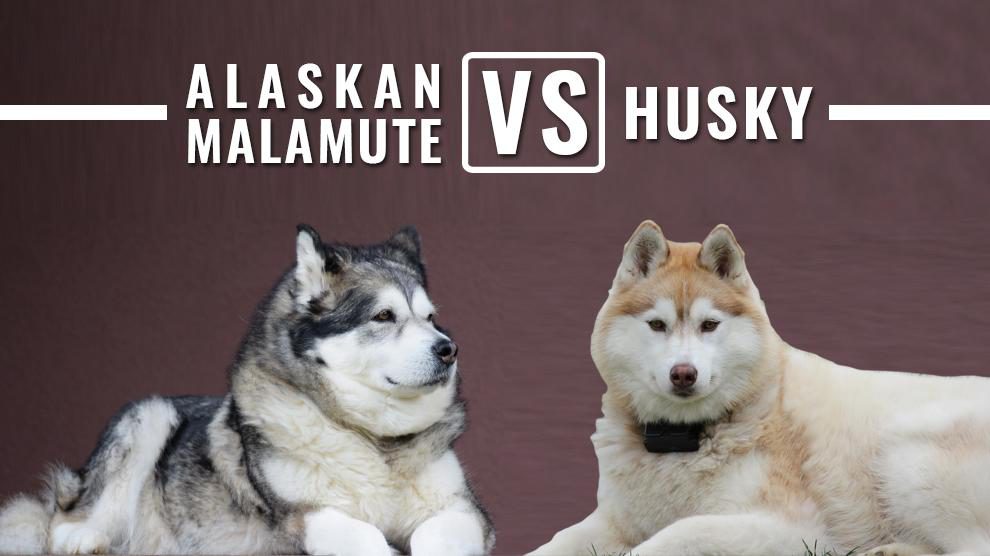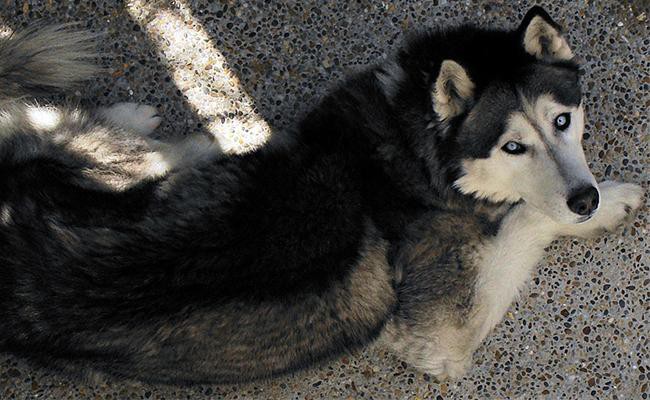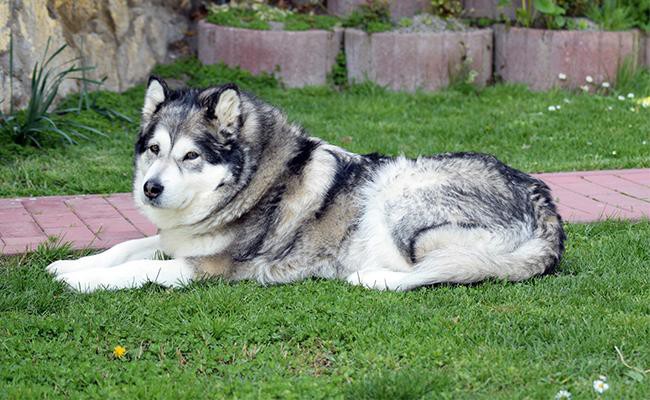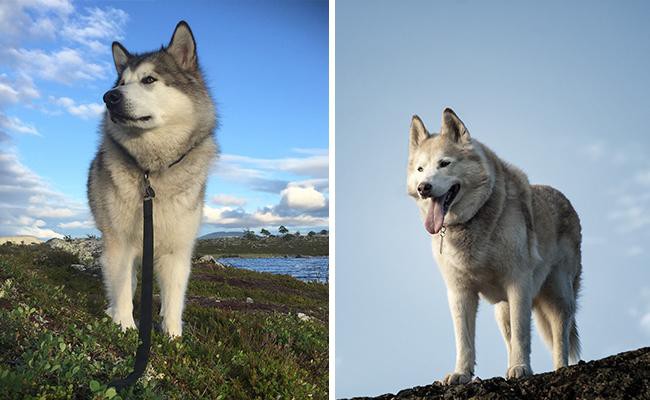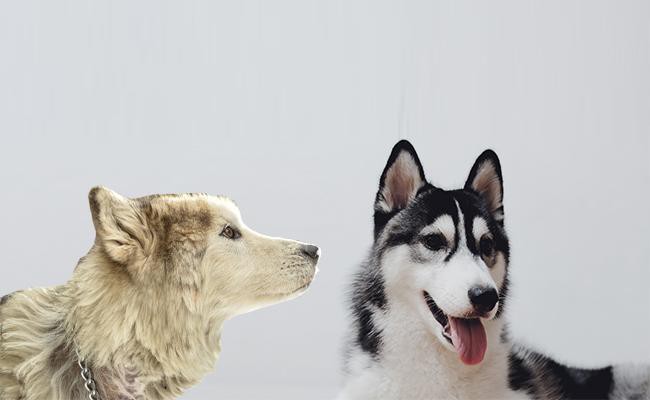Dog Pregnancy Calculator And Timeline
Have you ever seen similar Eskimo dogs and got confused over them? You might have seen the Alaskan malamute and the Siberian husky!
Confusion over these sled dogs is common due to their wolf-like appearance and similar physical characteristics. It is therefore quite difficult to identify them with an untrained eye!
Both the Alaskan malamute and Siberian husky are large, pretty, active and energetic dogs. But, their temperament and purpose of their lives are different!
In general, one breed is distinct from the other. But, this fact doesn’t fit exactly for Siberian husky and the Alaskan malamute. For example, huskies are notable for their speed whereas the malamute is notable for its strength.
It is essential therefore to know what exactly makes the difference between them. These differences will definitely help you to choose the one that meets your needs.
But, before looking into the differences, let’s take an overview of both the dogs.
Siberian Husky: An overwiew
It is a medium-sized sled dog that was bred to carry light loads at a slow pace over long distances. Siberian husky is also the most popular dog and it ranks 12th among 192 popular dogs recognized by the American Kennel Club.
Friendly and intelligent, it is a pack dog, too! An energy reservoir, it requires a lot of exercise for mental stimulation. If not provided enough exercise, it will become destructive. Siberian Huskies love to be independent and don’t like to spend time with people.
Alaskan Malamute: An overview
This breed appeals you with their size and appearance. But, you may have the confusion from its appearance that it is a wolf. Also, the malamute is loaded with energy and it loves hiking and backpacking.
So, it best suits the people having an active outdoor lifestyle. A loyal dog, this breed loves to spend time with people happily. The Alaskan malamute was bred initially to pull heavy sleds over long distances due to the high energy levels and physical stamina.
This dog also needs a lot of activity for mental stimulation. Like the Siberian husky, it will also engage in chewing and howling activities if not provided enough exercise!
Appearance
Although malamute and Siberian husky looks like a wolf, you can distinguish them with a few noticeable physical characteristics such as eye colors, body shape, tail, etc.
Eye Colors
Alaskan Malamute:
You can easily identify the malamute or the husky with its eye color. Malamutes always have brown eyes. But, the eye color of Siberian husky differs.
Siberian Husky:
Huskies may have brown, blue eye colors or a combination of both. But, many dogs of this breed have striking blue eye colors. White Siberian husky with blue eyes will make you fall in love with it!
Body
Alaskan Malamute:
Malamute’s body is filled up of muscles and bones. It is a well muscled, heavy boned, deep-chested dog with broad shoulders and looks like a powerful, balanced warrior.
Mals can stand well over its paws, revealing its activeness. They have broad, erected head and eyes showing curiosity and alertness.
Their muzzle is bulky, reduced in width from root to nose.
Their eyes are triangular and erected when it is alert. They also have a cap over their head, white face with markings such as a mask or a bar.
Malamute has a well-furred tail that carries over the back and appears like a waving plume.
Siberian Husky:
Siberian husky’s body is filled up with fur. Its body is moderately compact and it stands light on his feet. Husky’s gait is effortless and smooth.
This breed’s body proportions reflect the balance of speed and power.
Its ears are erected and eyes show mischievous expression. It also has a fox-brush shaped, well-furred tail that carries over its back when it is alert.
This dog can have various markings on its head, including the striking patterns.
Size And Lifespan
Size
A minor difference between these breeds is their size. The Alaskan malamute is undoubtedly the larger dog than the Siberian husky and it stands up to 25 inches. And, the Siberian husky will grow up to 22 inches.
Regarding weight, the Malamute is heavier than the husky (85-100 pounds). The adult husky dog weighs around 60 pounds and looks lighter than the Malamute.
Lifespan
Alaskan Malamute:
Speaking about life span, you can expect a short life span for Alaskan Malamute as large dogs are more prone to health issues. The average life span of this breed is 10 to 14 years.
So, the majority of the malamute dogs will live around 11 years.
Siberian Husky:
Compared to the malamute, Siberian husky has quite a long life span. On average, this breed lives for about 12 to 14 years. Also, it is considered a healthy breed.
Coat Colors
Coat Type
Both the malamute and the husky are double-coated dogs. But, the coat length and color varies among them. The Malamutes have a long coat and the husky’s coat is of medium length.
Malamutes have a thick and coarse outer coat that protects the soft, dense, wooly and oily undercoat. In the case of Siberian husky, its soft, dense undercoat of sufficient length protects the outer coat.
Coat Color
The Alaskan malamute’s coat color may range from black, light gray, white to shades of red. But, the undercoat belly is always white despite the coat cooler. The Siberian husky may have red, gray, black, sable and white coat colors.
One peculiar type of Siberian husky is the Agouti husky. It is completely different from the Alaskan malamute. This dog has a mix of black and gray coat colors with a white hint on its chest and belly.
Temperament
As both the dogs are bred as sled dogs, their purpose is to work with a pack of dogs and live with people. Also, they earn a reputation for loyalty. Therefore, you can see only minimal differences in their temperament.
Personality
But, you can notice that the Alaskan malamute is reserved with strangers and aggressive toward the same sex dogs. And, the Siberian husky will welcome the strangers and feels comfortable with other dogs.
Also, the Alaskan malamute is known for its strength and the Siberian Husky is notable for its speed. The malamute can pull the heavy loads up to 3000 lbs for long distances.
But, the Siberian husky seeming effortless but graceful in action, it can carry light loads at a moderate speed over long distances.
Although both dogs are loyal with their owners, Mals are friendly with people and love to spend time with them. But the Siberian husky wants to be independent and can spend time happily without human interaction.
Alaskan Malamutes are playful, friendly and confident. Huskies are friendly, fastidious, and dignified
Now, let’s know about which among the two is a great guard dog and a wonderful family pet!
Guarding Tendencies
Mals have a high prey drive and are generally offensive toward other dogs. That is, they are intolerant toward their counterparts. Regarding Siberian husky, it also has a high prey drive but has a higher tolerance for other dogs.
That is, they are friendly and outgoing with other dogs. So, the Siberian husky will definitely play the role of guard dog in a good manner!
Noise Levels
The noise factor is also a way to compare the Mals and the Siberians. Both breeds have barking tendencies.
But, the husky is a chatterbox specifically in groups. Malamutes have a less vocal reputation when compared with the Siberians. So, mals are considered as quiet.
You can avoid your puppy becoming a noisy adult by not rewarding their conversation.
Shedding And Grooming
Brushing
The grooming needs of both breeds are similar in most ways. Both have a thick, waterproof double coat and they shed seasonal (spring and fall).
Therefore, regular brushing and grooming are essential for these dogs to keep the shedding hair under control and to keep the coat clean and healthy. Also, both breeds need regular trimming of their nails and ear cleanings. You have to brush the coat of malamute at least thrice a week.
Cleaning And Bathing
Give a good shampoo bath once in 2 months. Weekly bathing is required only for the show malamutes. Other than that, you have to regularly trim its nails.
Huskies are considered a clean breed naturally. They self-clean themselves and need only occasional bathing. They also need brushing at least once a week to keep the coat and skin in good condition.
So, the only difference between their grooming needs is the brushing frequency.
Training And Exercise Needs
Training Procedure
Generally, it is quite challenging to train sled dogs. But, you have to know which among the two is easy to train when compared with the other.
A few malamute owners describe it as stubborn. Malamutes are also aggressive toward other dogs. Socialization and obedience training is essential for this dog to get along with children and other pets.
But, they are intelligent and willful too. So, patience will yield the trust in your relationship with it! Meanwhile, the Siberian husky is no exception to early socialization and obedience training.
Huskies are social and therefore making the training with patience and dedication and a lot of fun will be the best approach.
As both the dogs are independent in their own ways, they will respond to positive reinforcement and reward-based training methods.
So, avoid using aversive techniques while you train them! Also, malamutes like food treats and the Huskies love toys as rewards generally.
Exercise Needs
Regarding exercise needs, both the dogs are active, energetic and need a lot of space to run and play. They even want to have long walks every day! Yet, their exercise needs differ.
Alaskan Malamute:
Mals have high energy levels and need regular activities for mental stimulation. They are strong, athletic dog that loves running, hiking, romping, swimming and backpacking.
These dogs also take part in obedience and agility trials, weight pulling, competitive sledding and skijoring.
But if not provided enough exercises, it will feel boredom and engage in disruptive behaviors such as chewing and howling.
Siberian Husky:
Siberian Huskies are also athletic dogs and need exercises that help to strengthen the bond between them and their master. They love running, rally, obedience and agility trials. As Siberians are social toward people, it should not be left alone all day!
But, both the breeds have some kind of undesirable behaviors such as digging, jumping, etc. So, always keep them on a leash while taking for long walks, running and playing. Also, ensure that these dogs are playing in a securely fenced area.
Health Problems
Both the breeds are prone to some kind of health issues such as hip dysplasia. But, it is vital to know which is healthy in comparison to the other.
Alaskan Malamute:
As a large dog, the malamute is more prone to dysplasia where thigh bone fails to fit accurately into the dog’s hip joint, elbow dysplasia, thrombopathia, chondrodysplasia (dwarfism), hypothyroidism, von Willebrand’s disease, inherited polyneuropathy, and day blindness.
Siberian Husky:
The Siberian husky is generally a healthy breed. But, they may also get affected by juvenile cataracts. Also, they may be prone to thyroid dysfunction, juvenile cataracts, corneal dystrophy, progressive retinal atrophy, and hip dysplasia.
Therefore, both the malamute and the husky require health testing.
Price
A major distinguishing factor between any two dog breeds is the price factor. It also helps to choose the puppy that you want.
Alaskan Malamute:
The mals usually cost higher than the Siberians. On average, the price of the malamute is from $1200 to $1700. Sometimes, you have to spend up to $2000 in order to buy a mal. Matured mals and rescue malamutes are considered cheaper.
Siberian Husky:
The Siberian husky generally costs around $600 to $1300 based on parental lineage. Like the malamute, a matured or rescue Husky’s price is less.

